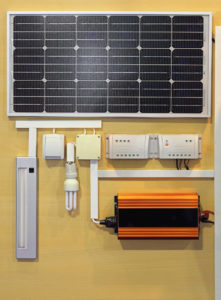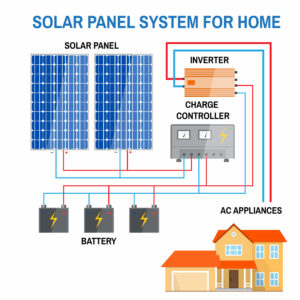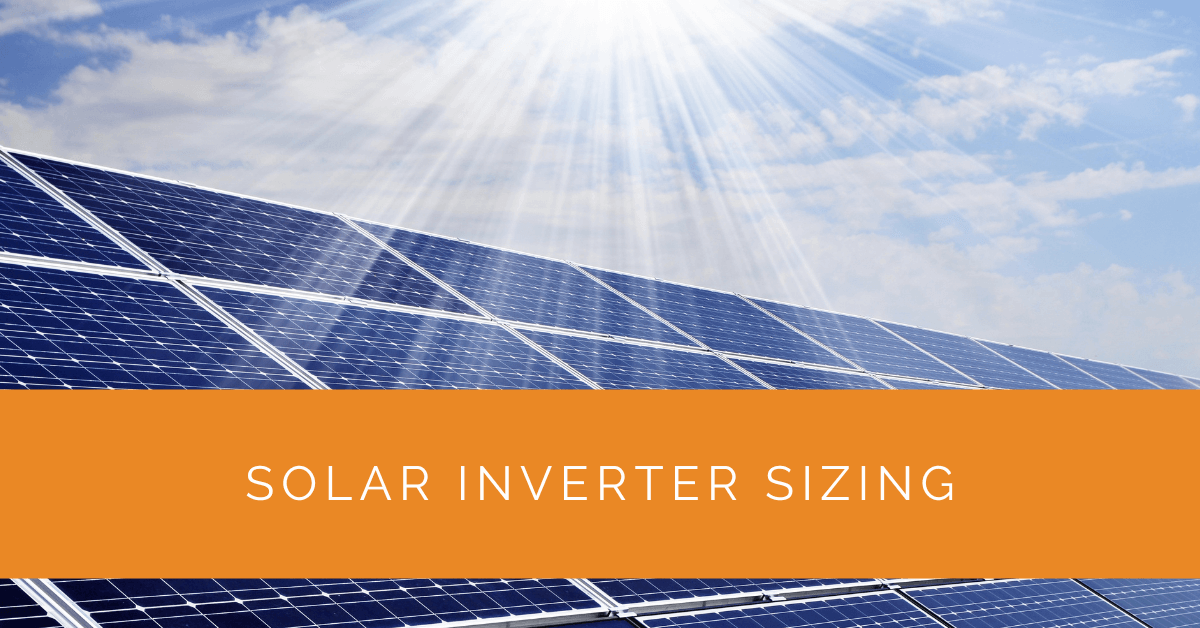Solar inverters play a crucial role in a solar panel system, converting the direct current (DC) produced by solar panels into usable alternating current (AC) electricity. To ensure optimal performance and efficiency, it is essential to understand the importance of properly sizing your solar inverter. This article will delve into the intricacies of solar inverter sizing, exploring the factors to consider and the guidelines for selecting the right size inverter for your solar system.
Contents
- 1 Key Takeaways
- 2 Basics of Solar Inverter Sizing
- 3 Matching Inverter Size to PV Array
- 4 Considering Load Profile and Power Demand
- 5 Understanding AC Output and Inverter Capacity
- 6 Inverter Efficiency and System Performance
- 7 Inverter Sizing Guidelines for Solar Design
- 8 Case Study: Optimizing Solar Inverter Sizing for Maximum Efficiency
- 9 Expert Insights From Our Solar Panel Installers About Solar Inverter Sizing
- 10 Experience Solar Excellence with Us!
- 11 Conclusion
Key Takeaways
- Proper solar inverter sizing is crucial for optimizing your solar system’s performance and energy production.
- Matching the inverter size to the PV array and considering the load profile and power demand are essential factors in determining the appropriate inverter capacity.
- Inverter efficiency, understanding AC output specifications, and following sizing guidelines for different solar designs contribute to maximizing system performance and ensuring seamless integration with your electrical infrastructure.
Basics of Solar Inverter Sizing
Understanding the fundamentals of solar inverter sizing is crucial for optimizing your solar system’s performance. Properly sizing your solar inverter involves selecting the right capacity or power rating that aligns with the characteristics of your photovoltaic (PV) array and the power demands of your electrical loads. Let’s delve into the key aspects of solar inverter sizing.
The Role of Solar Inverters
Solar inverters are a vital component of solar energy systems. They convert the direct current (DC) electricity generated by solar panels into alternating current (AC) electricity that can be used to power your home or business. Inverter sizing ensures that the conversion process is efficient and maximizes the energy production of your solar system.
Factors Influencing Inverter Sizing
Several factors come into play when determining the appropriate inverter size for your solar system. These factors include the size of your solar array, the load profile, and the overall system design. By considering these factors, you can select an inverter that meets the specific requirements of your solar setup.
Matching Inverter Size to PV Array
Properly matching the inverter size to the power output of your PV array is crucial for optimal performance and energy production. This ensures that the inverter can handle the maximum power your solar panels generate without operating below or exceeding its capacity.
Determining Maximum Power Output
To accurately size your inverter, you need to determine the maximum power output of your PV array. This value represents the highest energy solar panels can produce under ideal conditions. It is typically specified in watts (W) or kilowatts (kW).
Selecting an Appropriate Inverter Capacity
Once you know the maximum power output of your PV array, you can select an inverter capacity that matches or slightly exceeds this value. Oversizing the inverter can lead to inefficiencies and increased costs, while under-sizing can limit your system’s energy harvest potential. It is crucial to strike the right balance by choosing an inverter capacity that aligns with your PV array’s output.
Avoiding Oversizing or Undersizing
Oversizing the inverter may seem beneficial in maximizing energy production. However, excessive oversizing can result in the inverter operating below its optimum efficiency range, reducing its overall performance. On the other hand, under-sizing the inverter may restrict the power output of your solar system, limiting its ability to meet the electrical demands of your loads. Careful consideration and accurate sizing are key to finding the optimal inverter capacity for your PV array.

Considering Load Profile and Power Demand
To accurately size your inverter, it is important to consider your load profile and the power demands of your electrical loads. Understanding your load profile helps estimate your appliances’ peak power demand and consumption patterns, allowing you to select an inverter that can handle the required power.
Analyzing Load Profile
Evaluate your load profile by identifying your system’s electrical devices and appliances and their corresponding power requirements. Consider peak power demand, daily energy consumption, and surge power requirements. This analysis provides insights into the specific power demands of your loads, enabling you to make an informed decision when sizing your inverter.
Managing Surge Power
Certain loads, especially those with motorized components like refrigerators or air conditioning units, require surge power during startup. These motorized loads can have a momentary high power demand that needs to be accommodated by the inverter. When sizing your inverter, it is important to account for surge power requirements to ensure your electrical devices’ smooth and uninterrupted operation.
Understanding AC Output and Inverter Capacity
Your inverter’s AC output and capacity are essential considerations when selecting the appropriate size for your solar inverter. Understanding the AC output specifications and the inverter’s capacity will help ensure compatibility with your electrical system and the ability to meet your power needs.
AC Output Voltage and Frequency
When choosing a solar inverter, it is crucial to ensure that the AC output voltage and frequency align with the electrical standards of your location. The voltage and frequency must be compatible with your existing electrical infrastructure to ensure seamless integration. Common AC output voltages include 120V and 240V in residential settings, while frequencies typically range from 50Hz to 60Hz, depending on the region.
Inverter Capacity and AC Power
The inverter’s capacity determines its ability to deliver sufficient AC power to meet your electrical load requirements. Inverter capacity is typically expressed in kilowatts (kW) and represents the maximum power output the inverter can provide. Selecting an inverter with a capacity that aligns with your power demands is essential, ensuring that it can comfortably handle the electrical load without overloading.
Balancing Inverter Size with Electrical Load and Circuit Breaker Capacity
To avoid electrical overload and ensure safety, it is crucial to balance the size of the inverter with the capacity of your electrical loads and circuit breakers. If the inverter capacity exceeds the load demand or the rating of the circuit breakers, it can lead to tripped breakers or potential damage to the electrical system. Consider the power demands of your loads and ensure that the inverter capacity aligns with the capabilities of your electrical infrastructure.

Inverter Efficiency and System Performance
The efficiency of your solar inverter plays a significant role in your solar system’s overall performance and energy production. High-efficiency inverters convert a larger proportion of DC power from the solar panels into usable AC electricity, reducing energy losses and maximizing the system’s output.
Impact of Inverter Efficiency
Inverter efficiency is the ratio of output power to input power, expressed as a percentage. Higher efficiency means less energy loss during conversion, resulting in greater overall system performance. When selecting an inverter, opt for models with higher efficiency ratings to ensure that a larger portion of the solar energy is effectively converted into usable electricity. Improved efficiency contributes to higher energy yields and increased financial returns over the system’s lifetime.
Considering Temperature Derating and Heat Dissipation
Solar inverters can experience reduced efficiency at higher temperatures. It is important to consider temperature derating, which refers to the decrease in inverter performance as temperatures rise. When sizing your inverter, consider the expected operating temperatures in your location and select a model that can handle these conditions without significant efficiency losses.
Proper heat dissipation is also crucial for maintaining inverter performance and longevity. Adequate ventilation and proper installation practices help dissipate heat and prevent the inverter from overheating. Ensuring that the inverter is placed in a well-ventilated area and following manufacturer guidelines for installation can optimize heat management and enhance overall system performance.
Inverter Sizing Guidelines for Solar Design
Inverter sizing guidelines vary depending on your solar system’s specific design and requirements. Understanding these guidelines is essential for selecting the appropriate inverter size and ensuring optimal system performance.
Residential and Commercial Systems
For grid-tied residential and commercial systems, it is generally recommended to size the inverter close to the nameplate capacity of the solar array. This allows for efficient energy conversion and utilization. However, local utility interconnection standards and regulations may have specific requirements or limitations on inverter sizing, so it is important to consult with relevant authorities or solar professionals to ensure compliance.
Off-Grid and Hybrid Systems
Off-grid and hybrid solar systems incorporate battery storage and have unique considerations for inverter sizing. In these systems, the inverter must be sized to accommodate both the power demands of the electrical loads and the charging/discharging of the battery bank. The inverter capacity should be determined based on the maximum load demand and the energy storage requirements of the batteries.
Off-grid systems require a larger inverter capacity to handle the peak load demand and to supply power during periods of low or no sunlight. It is crucial to consider the size of the battery bank and its ability to provide sufficient power to meet the load demand during periods of limited solar energy generation.
On the other hand, hybrid systems combine solar power with an additional energy source, such as a generator or the grid. Inverter sizing for hybrid systems should consider the solar array’s capacity, battery bank, and additional energy source. The inverter must manage the power flow between these sources efficiently to ensure uninterrupted power supply and optimal system performance.
Case Study: Optimizing Solar Inverter Sizing for Maximum Efficiency
Background
Solar Panels Network USA was tasked with designing and installing a solar energy system for a medium-sized commercial facility in Arizona. The goal was to maximize energy production and efficiency while ensuring the system could handle the facility’s varying power demands.
Project Overview
The commercial facility, known for its commitment to sustainability, required a solar system that could provide substantial energy savings and reduce its carbon footprint. Solar Panels Network USA conducted a thorough analysis to determine the optimal solar inverter sizing, considering the facility’s energy needs and load profile.
Implementation
Site Assessment and Load Analysis
Our team performed a detailed site assessment and load analysis to understand the facility’s energy consumption patterns. We evaluated peak power demands, daily energy usage, and the presence of any motorized equipment requiring surge power.
PV Array Design
We designed a PV array with high-efficiency solar panels, ensuring maximum sunlight capture and energy generation. The array’s total capacity was calculated to match the facility’s energy requirements, providing a foundation for selecting the appropriate inverter size.
Inverter Selection
Based on the PV array’s capacity and the load analysis, we selected inverters with a combined capacity slightly exceeding the array’s maximum power output. This approach ensured optimal energy conversion without the risk of oversizing, which could lead to inefficiencies.
Advanced Monitoring Systems
We integrated advanced monitoring systems to track the solar system’s performance in real-time. These systems provided insights into energy production, system efficiency, and potential issues, allowing for proactive maintenance and adjustments.
Results
Optimized Energy Production
The accurately sized inverters ensured efficient energy conversion, maximizing the facility’s solar energy production. The system consistently operated at peak efficiency, providing reliable power to meet the facility’s needs.
Cost Savings and ROI
The optimized inverter sizing led to significant cost savings on energy bills. The facility experienced a favorable return on investment, with reduced operational costs and enhanced energy independence.
Environmental Impact
The solar system significantly reduced the facility’s carbon footprint, aligning with its sustainability goals. The shift to renewable energy contributed to lower greenhouse gas emissions and supported the facility’s commitment to environmental stewardship.
Summary
This case study highlights the importance of proper solar inverter sizing in achieving maximum efficiency and performance for solar energy systems. By accurately matching inverter capacity to the PV array and considering the facility’s load profile, Solar Panels Network USA delivered a solution that optimized energy production and provided substantial cost savings. Our expertise in solar technology and commitment to sustainability ensure that each project contributes to a greener and more energy-efficient future.
Expert Insights From Our Solar Panel Installers About Solar Inverter Sizing
Properly sizing your solar inverter is crucial for optimizing system performance. An accurately sized inverter ensures efficient energy conversion and maximizes the potential of your solar panels.
Lead Solar Engineer
Considering your load profile and power demand is essential when sizing a solar inverter. It helps avoid overloading and ensures your system can handle peak loads effectively.
Senior Solar Installer
Balancing inverter capacity with your PV array’s output and the electrical load is key to maintaining system efficiency and reliability. It’s about finding the right fit to achieve seamless energy flow.
Solar Energy Consultant
Experience Solar Excellence with Us!
Trust in Solar Panels Network USA, where our seasoned experts deliver top-quality solar solutions for homes and businesses nationwide. With a legacy of countless successful installations and a commitment to sustainable energy, we’re your reliable partner in the solar journey. Ready for a brighter, eco-friendly future? Call us now at (855) 427-0058 and harness the power of the sun!
Conclusion
Solar inverter sizing is critical to designing an efficient and reliable solar energy system. Properly matching the inverter size to the PV array, considering the load profile and power demand, understanding AC output specifications and inverter capacity, and optimizing inverter efficiency are all essential steps in the sizing process. By following these guidelines, you can ensure that your solar inverter operates efficiently, maximizing energy production and meeting the power requirements of your electrical loads. Seeking the assistance of solar professionals and utilizing appropriate tools and resources will further aid in determining the optimal inverter size for your specific solar design. Remember, accurate inverter sizing is key to unlocking your solar system’s full potential and harnessing the sun’s clean, renewable power.
About the Author
Solar Panels Network USA stands at the forefront of solar energy solutions, driven by a team of seasoned solar engineers and energy consultants. With over decades of experience in delivering high-quality solar installations and maintenance, we are committed to promoting sustainable energy through customer-centric, tailored solutions. Our articles reflect this commitment, crafted collaboratively by experts to provide accurate, up-to-date insights into solar technology, ensuring our readers are well-informed and empowered in their solar energy decisions.

